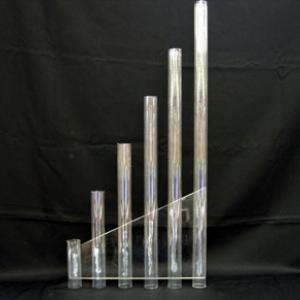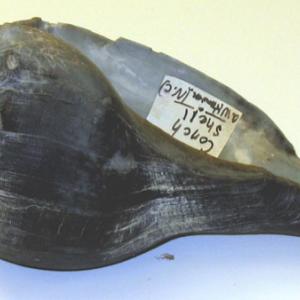College of Liberal Arts & Sciences
3D30.14 - Open Tube Resonance - Ambient Noise Resonators
Listen to the ambient noise with each pipe. Certain frequencies will resonate depending on tube size and length. Octaves can be heard depending on whether the pipe is away from the ear in an open configuration or against the ear in the closed configuration.
The Sea Shell is not a Helmholtz Resonator. The air volume of the shell will be exited at the shells resonant frequencies, of which there should be several. This shell has several resonances at frequencies below 300 Hz.
- Joe Pizzo, "Echo Tube", TPT, Vol. 24, # 7, Oct. 1986, p. 428 - 429.
- Thomas Rossing, "Open and Closed Tube Resonators", TPT, Vol. 24, # 8, Oct. 1986, p. 459.
- Joe Pizzo, "Response", TPT, Vol. 24, # 8, Oct. 1986, p. 459.
- Joe Pizzo, "Deck the Halls...with interactive corridor demonstrations: Ambient Noise Resonators (There's Music in the Air)", TPT, Vol. 24, # 5, May 1986, p. 312 - 313.
- Thomas B. Greenslade, Jr., "Savart's Resonator", AJP, Vol. 92, #5, May 2024, p. 359.
- Thomas B. Greenslade, Jr., "Resonant Cylinders", AJP, Vol. 91, #8, Aug. 2023, p. 643.
- Michael J. Moloney, Daniel L. Hatten, "Acoustic Quality Factor and Energy Losses in Cylindrical Pipes", AJP, Vol. 69, # 3, March 2001, p. 311.
- George M. Hopkins, "Sound", Experimental Science, p. 142.
- Pat Murphy, Ellen Macaulay, and the Staff of the Exploratorium, "Making Music", Exploratopia, p. 216.
- Janice VanCleave, "Design a Musical Instrument That Can Play Different Pitches", Super Science Challenges, p. 130.
- Jearl Walker, "3.36, Conch Shells", The Flying Circus of Physics Ed. 2, p. 161.
- "Pipes of Pan", Exploratorium Science Snackbook, p. 77-1 - 77-2.
- Ron Hipschman, "Pipes of Pan", Exploratorium Cookbook III: A Construction Manual for Exploratorium Exhibits, Recipe No. 189, p. 189-1 - 189-3.
- Tom Senior, "Mass Production of Pan Pipes", Pan Pipes.
Disclaimer: These demonstrations are provided only for illustrative use by persons affiliated with The University of Iowa and only under the direction of a trained instructor or physicist. The University of Iowa is not responsible for demonstrations performed by those using their own equipment or who choose to use this reference material for their own purpose. The demonstrations included here are within the public domain and can be found in materials contained in libraries, bookstores, and through electronic sources. Performing all or any portion of any of these demonstrations, with or without revisions not depicted here entails inherent risks. These risks include, without limitation, bodily injury (and possibly death), including risks to health that may be temporary or permanent and that may exacerbate a pre-existing medical condition; and property loss or damage. Anyone performing any part of these demonstrations, even with revisions, knowingly and voluntarily assumes all risks associated with them.

